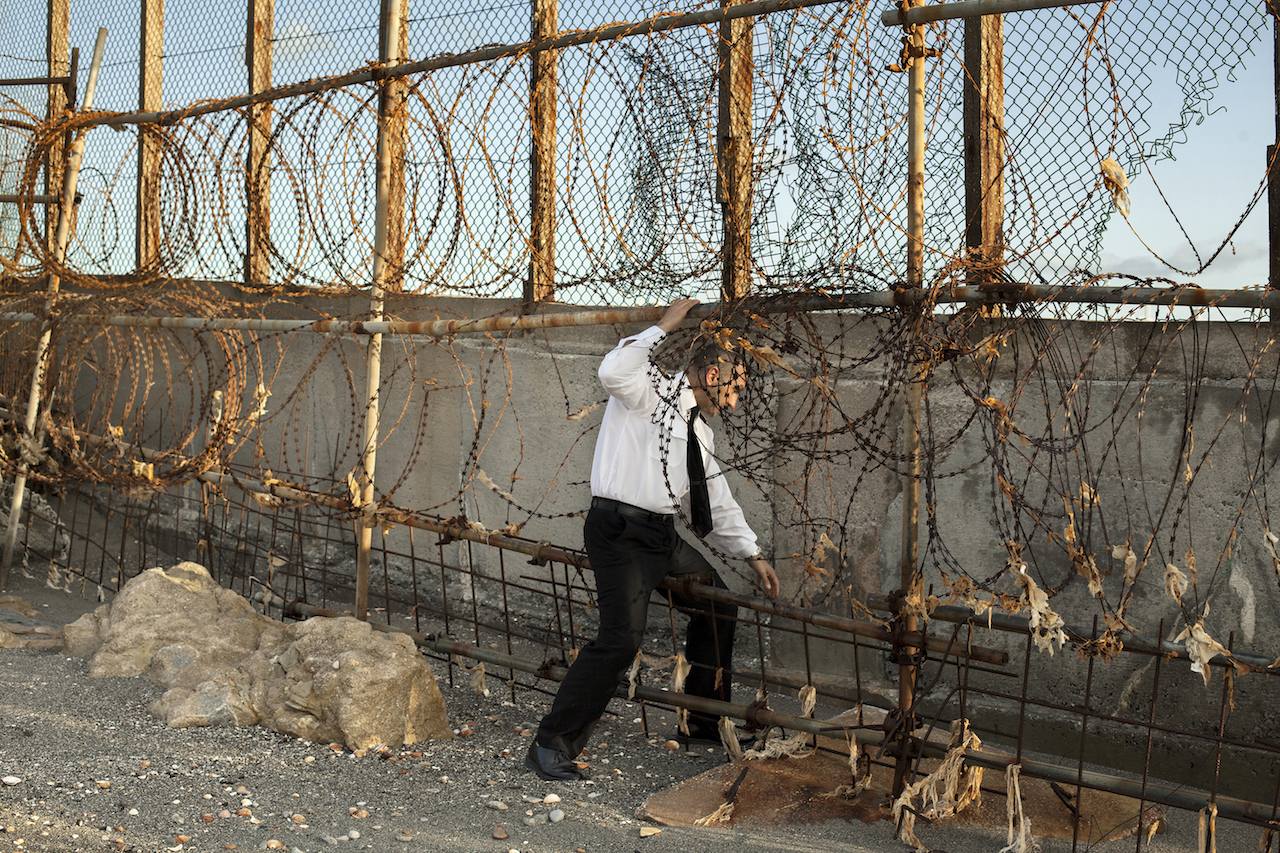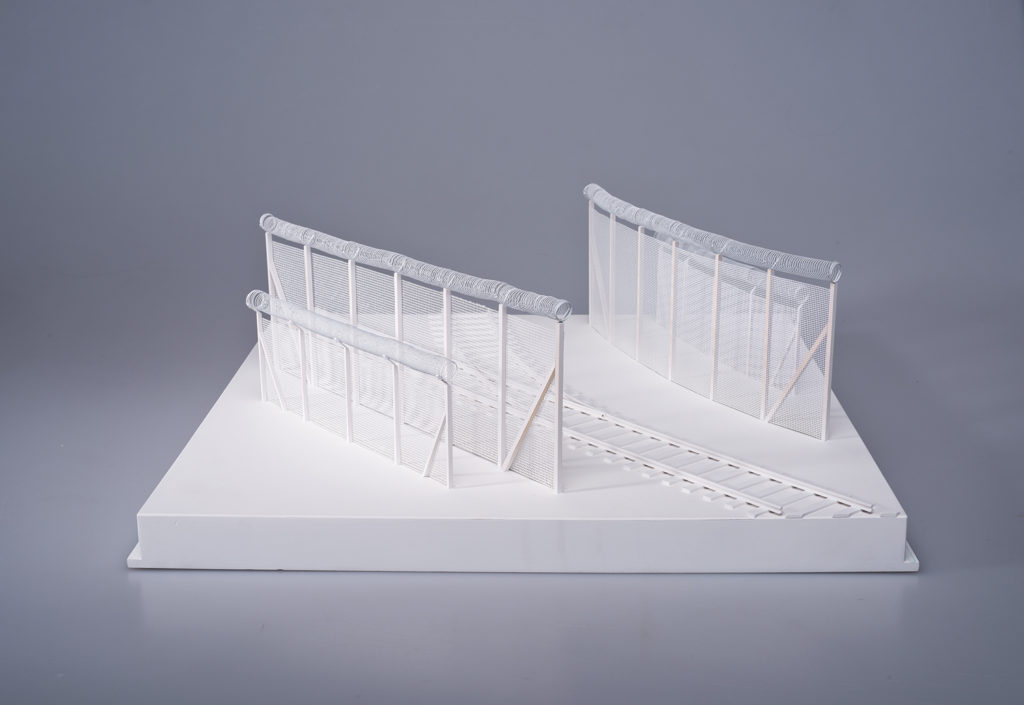The Fence of Gibraltar, British Overseas Territory of Gibraltar, 2016 © Arnau Bach, courtesy of the artist.
An exhibition at Les Rencontres d’Arles explores the motivations behind 30 existing man-made borders in Europe
In 1989, the Iron Curtain began to be dismantled as the Cold War drew to an end. . Two years later, the Berlin Wall fell, paving the way for German reunification and the dissolution of the Soviet Union. During an era defined by global militarised segregation, there were only four physical walls that existed to demarcate borders in Europe. Today, however, there are close to 30.
In 2015, when Hungarian curator and photo editor István Virágvölgyi heard that his country was building a fence along its border with Serbia and Croatia, he became curious about other walls across the continent. “I thought there might be five or so, but there were so many more,” he says. After investigating the various motives behind man-made barriers such as the peace lines in Belfast, the Kaliningrad Oblast (a 45km fence that separates Lithuania and Russia), and the 6m high Melilla border fence between Spain and Morocco, Virágvölgyi realised that “although they look the same, their purpose is different”.
Created with the support of the Les Rencontres d’Arles curatorial fellowship, Walls of Power is split into three sections: Walls of Influence, Walls of Segregation, and Walls of Migration. Spanning photography, film, and sculpture, the exhibition presents 128 pieces of work by 44 contributors from 15 different countries. For Virágvölgyi, it was particularly important to include work by local photographers living nearby the barriers who knew their history. He also wanted to platform a variety of perspectives and included work by photographers, activists, civilians and even refugees.
Taking the Iron Curtain and the Berlin Wall as a point of reference, Virágvölgyi divides these 30 existing walls between these three sections.
WALLS OF INFLUENCE
Walls of influence relates to “barriers between sovereign powers; boundaries that are politically driven, motivated by the desire to reign,” explains István Virágvölgyi. This section includes images made in Cyprus by George Georgiou and Tijen Erol. The series explores the United Nations Green Line Buffer Zone, a product of the Greek-Turkish conflict that divides the island, and the Fence of Gibraltar, which was built on the country’s border with Spain by Britain in 1909.
Also explored is the notion of “digital walls”, through two projects that were commissioned for the exhibition. The first is a series by Russian activist Lvova Anastasya, which investigates digital firewalls in Russia. We also see images of foreign embassies captured on Google Street View by Marcell Piti, showing how embassies around the world have blurred and distorted their properties for security purposes.
Cyprus has been divided by the UN Buffer Zone, the 180 km “Green Line”, since 1974. In just half a century the houses and shops inside the zone have become like ruins. Today, no-one, not even the owners, are allowed to return back to their properties inside the zone or to visit the area. The Wall, Nicosia, Cyprus, 2015. © Tijen Erol, courtesy of the artist.
US Embassy in Belgrade, Serbia, obscured by the government and captured using Google Street View, 2018. © Marcell Piti, courtesy of the artist.
WALLS OF SEGREGATION
Walls of Segregation refers to barriers that are built within a society by local authorities who wish to separate a minority from the rest of the community. Here, we see a multimedia piece by András D. Hajdú and Balázs Ivándi-Szabó, exploring the gypsy ghettos of Baia Mare in Romania, in which one settlement was walled off by local authorities in 2011. Also included is Attila Balázs’ striking image of a Roma family walking towards a concrete wall that separates their camp from a housing estate in Eastern Slovakia.
We also see images from Frankie Quinn’s documentation of the Belfast Peace Lines that divide the city’s Catholic and Protestant communities, as well as shocking footage by Russian filmmaker Timofey Rozhansky, who documents the inside of Russia’s “undesirable” walled communities, isolated for the sake of the nation’s reputation during important state visits.
Around 50 families living in panel housing on a housing estate in Eastern Slovakia funded the erection of the 500-metre-long, 2m high wall that separates them from the local Roma camp © Attila Balázs, courtesy of MTI
A still from a multimedia piece showing the gipsy ghettos of Baia Mare, Romania, one of which was walled off by the local municipality in 2011 © András D. Hajdú and Balázs Ivándi-Szabó, courtesy of the artists.
WALLS OF MIGRATION
A sense of urgency permeates the last section of the show, in which we are confronted with the many barriers blocking entry into the fortress that is Europe. We see an extreme act of willful ignorance in José Palazón’s 2014 image of refugees climbing the Melilla fence in Spain and Morocco, as a golfer below hits a tee shot. Elsewhere, Kevin McElvaney creates a space for a refugees’ perspective with a project for which he handed out 15 disposable cameras to families in Turkey and Greece to document their migration.
In this final section, we come face-to-face not only with the largest displacement crisis since World War II, but also the physicality of the walls that obstruct progress. Łukasz Skąpski’s neatly scaled models of existing European border barriers emphasise the actual existence of these physical barriers that separate us from our neighbours.
A train wagon at the railway station in Zákány, Hungary, carries razor that will be used on the country’s border with Croatia © Simon Móricz-Sabján, courtesy of the artist.
Young Africans try to climb the double fence that separates Africa from Europe, near Beni Enza on the border of Spanish enclave Melilla, March 2014. After spending several hours on top of the fence, they were forced back to Morocco by Spanish security forces. © Sergi Cámara, courtesy of the artist.
Calais, France, from the series The Clinch – New Architecture of European Borders © Łukasz Skąpski, courtesy of the artist
Building walls to protect a land, its people, and its culture is not a new phenomenon. But, looking back on the greatest walls that have existed, in the Soviet Union, China, and even Hadrian’s Wall in the Roman Empire, history proves that they are temporary. “Walls are always demolished. There have always been walls and there will always be walls. But they are imperfect,” says Virágvölgyi. “Walls are an instrument of power and control… Building a wall is never a solution to anything.”
Walls of Power is on show at Les Rencontres d’Arles, France, until 25 August 2019







